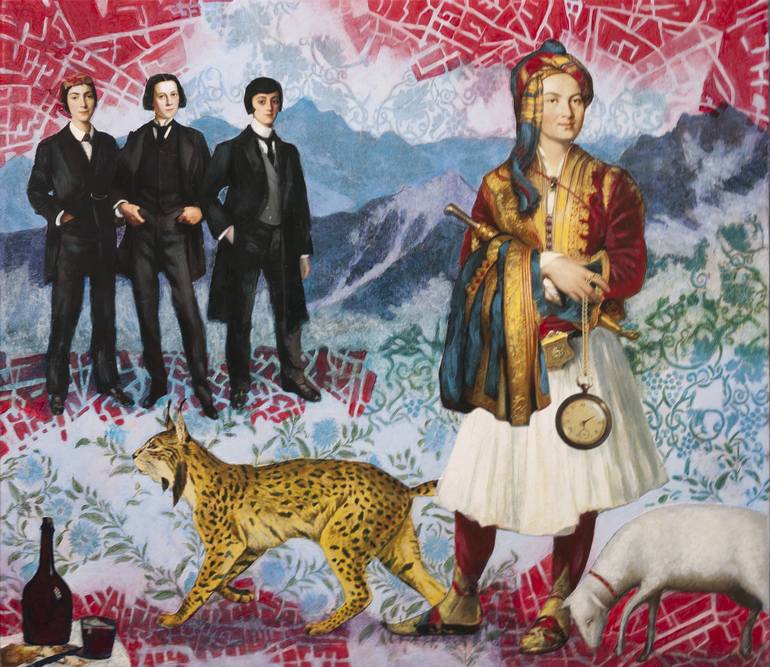


VIEW IN MY ROOM
The Sworn Virgins I Collage
United Kingdom
Collage, Paint on Wood
Size: 17.5 W x 15.5 H x 0.5 D in
About The Artwork
"The tradition of sworn virgins developed out of The Code of Lekë Dukagjini, a set of codes and laws developed and used mostly in northern Albania & Kosovo from the 15th century until the 20th century. The Code dictates that families must be patrilineal (meaning wealth is inherited through a family's men) and patrilocal (upon marriage, a woman moves into the household of her husband's family). Women are treated like property of the family and are stripped of many rights. They cannot smoke, wear a watch, or vote in their local elections. They cannot buy land, and there are many jobs they are not permitted to hold. However, a woman who becomes a sworn virgin by swearing an irrevocable oath, in front of twelve village or tribal elders, to practice celibacy, is then allowed to live as a man and may dress in male clothes, use a male name, carry a gun, smoke, drink alcohol, take on male work, act as the head of a household (for example, living with a sister or mother), play music and sing, and sit and talk socially with men. The sworn virgin is believed to be the only formal, socially defined trans-masculine, transgender and cross-dressing role in Europe. Breaking the vow was once punishable by death, but it is doubtful that this punishment is still carried out. Many sworn virgins today still refuse to go back on their oath because their community would reject them for breaking the vows. However, it is sometimes possible to take back the vows if the sworn virgin has finished her obligations to the family and the reasons or motivations which lead her to take the vow no longer exist. There are many reasons why a woman would have wanted to take this vow, and observers have recorded a variety of motivations. One woman said she became a sworn virgin in order to not be separated from her father, and another in order to live and work with her sister. Several were recorded as saying they always felt more male than female. Some hoped to avoid a specific unwanted marriage, and others hoped to avoid marriage in general. Becoming a sworn virgin was the only way for women whose families had committed them as children to an arranged marriage to refuse to fulfil it, without dishonouring the groom's family and risking a blood feud. It was the only way a woman could inherit her family's wealth, which was particularly important in a society in which blood feuds resulted in the deaths of many male Albanians, leaving many families without male heirs. It is also likely that many women chose to become sworn virgins simply because it afforded them much more freedom than would otherwise have been available in a patrilineal culture in which women were secluded, sex-segregated, required to be virgins before marriage and faithful afterwards, betrothed as children and married by sale without their consent, continually bearing and raising children, constantly physically labouring, and always required to defer to men, particularly their husbands and fathers, and submit to being beaten. Sworn virgins could also participate in blood feuds. If a sworn virgin was killed in a blood feud her death counted as a full life for the purposes of calculating blood money, rather than the half a life ordinarily accorded for a female death."
Details & Dimensions
Collage:Paint on Wood
Original:One-of-a-kind Artwork
Size:17.5 W x 15.5 H x 0.5 D in
Frame:Not Framed
Ready to Hang:No
Shipping & Returns
Delivery Time:Typically 5-7 business days for domestic shipments, 10-14 business days for international shipments.
Have additional questions?
Please visit our help section or contact us.
United Kingdom
I began producing elaborate mixed media pieces while on my long stay in Venice, making use of the city-floor ephemera of discarded museum leaflets and postcards. Incorporating ‘scraps’ of the past, sourced from secondhand books and magazines, and the maps I grew up with as the child of an intrepid Geophysicist, I produced a diary of sorts, the alternative reality of a history I invented for myself. I have since developed this way of working, often inspired by current events, creating ‘intricate scenes of social malfunction’, my investigations into ‘the human condition’ through a series of imagined portraits. I studied Fine Art at Oxford Brookes University, spending my final year at The School of the Art Institute of Chicago on an extended travel award. Graduating in 1992 I moved back to London, where for a time I slipped into the world of graphic design and illustration, working for Raymond Loewy International, and subsequently becoming Course Tutor at Lambeth College, and later a lecturer at Worcester University. By the late 1990s, emboldened to pursue my painting career by formidable gallery owner and art advocate the late Elizabeth Organ, a series of events shaped my subsequent work, beginning with the move from London to unfeasibly feudal Herefordshire, a turbulent marriage in a ‘Gormenghast’ of a castle, and a subsequent period of exile in Venice. My work has most recently been shown at the Royal West of England Academy, Bristol and the Mernier Gallery, London, with an increasing following of private European collectors from Southern France to Croatia. Represented by: The Martin Tinney Gallery Cardiff http://www.artwales.com/ Gala Fine Art, Bristol http://galafineart.uk
Thousands Of Five-Star Reviews
We deliver world-class customer service to all of our art buyers.
Global Selection
Explore an unparalleled artwork selection by artists from around the world.
Satisfaction Guaranteed
Our 14-day satisfaction guarantee allows you to buy with confidence.
Support An Artist With Every Purchase
We pay our artists more on every sale than other galleries.
Need More Help?